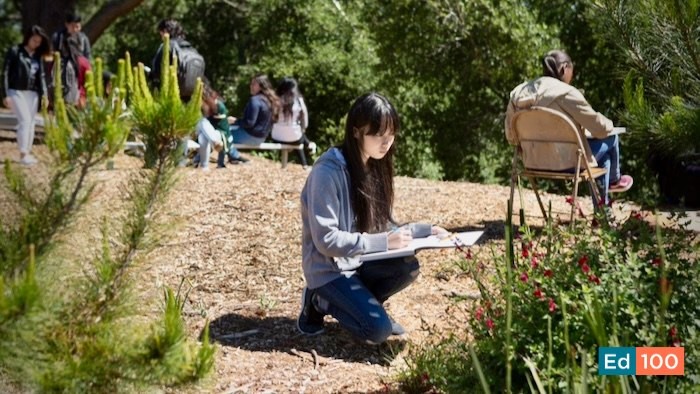Education and the Environment

School buildings, playgrounds and carbon
Throughout California, students and teachers spend classroom time learning about the climate crisis and its potential impacts.

Mary Perry
Meanwhile, their school buildings are usually heated and cooled with fossil fuels, their schoolyards and parking areas are vast areas of heat-emitting asphalt, and school district officials often lack the time or expertise to use available facility funds in ways that improve climate resilience.
These challenges are often most serious for schools that serve California’s most vulnerable students.
The Climate Ready Schools Coalition (CRSC)
A group of education, climate, health, youth, labor, civil rights, and business leaders from more than two dozen organizations in California want to address this disconnect. Members of the Climate Ready Schools Coalition (CRSC) are working together to support climate resilience and sustainability in the state’s schools.
A climate-resilient school reduces the health impacts of climate change, including exposures to toxic wildfire smoke and extreme heat. Such a school also works to decrease the harm to children’s academic progress and social-emotional development that result from climate-related disruptions such as flooding, extreme wind, and extreme temperatures.
A sustainable school is one that has “greened” its facilities and operations to reduce the ecological footprint and contribute as little as possible to the causes of climate change. Typical practices include, but are not limited to:
- energy and water conservation,
- zero waste practices,
- local and sustainable sourcing for food and resources,
- reduced exposure to toxins,
- green transportation efforts (walking and rolling, electric or alternative fuels vehicles, and carpooling and busses), and
- schoolyard greening.
Sustainable and climate-resilient schools are not only climate ready, but can also serve as laboratories for learning, and as models for a sustainable and climate ready future.
At the state capitol
The CSRC focuses its advocacy efforts in the place where environmental policies and education meet – the halls of the California Capitol in Sacramento. CRSC communicates with the Newsom administration, legislators and their staffs, and organizations outside of the Coalition, to make clear how specific state environmental policies will support or hurt schools and students.
In its first full year of operation, the Coalition earned a Best of Green Schools Award from the Green Schools National Network and USGBC Center for Green Schools. The lead organizations include Undaunted K12 and Ten Strands. The coalition’s website provides useful resources for anyone who wants to learn about current policy issues addressing equity, recent changes in solar metering policies, and incentives to further environmentally-sound investments.
Serving and safeguarding those most affected by the climate crisis.
“For children growing up in California today, the impacts of climate change are as close as the air they breathe. And yet… California’s public school buildings and campuses remain woefully underprepared for heat, smoke, drought, wildfire, and other extreme weather events … California has tremendous work to do in order to keep the state’s aging school buildings open, healthy and conducive to learning in the face of our rapidly changing climate.”
Introduction, Climate-Ready Schools Coalition: Call to Action
School facilities are a big part of California’s built environment. That makes them crucial to the state’s effort to reduce greenhouse gas emissions and reach its climate goals. However, school districts in California vary dramatically in their capacity to invest wisely in climate-friendly improvements and to prepare their school facilities for climate extremes and emergencies. Smaller districts and those that serve low-income communities are at a particular disadvantage in terms of both funding and expertise. Black, Latinx, and Native American students disproportionately attend these school districts.
If schools are to fulfill their crucial role in California’s efforts to address climate-related challenges, they need the state’s support. CRSC is urging policymakers to task the California Energy Commission with creating a statewide master plan. Such a plan would spark much-needed communication and coordination among state, county, and local agencies. It would also support and empower local school leaders by identifying approaches, including applying for federal incentives, that meet unique local needs and maximize the positive environmental impact of public investments in school facilities.
Solar incentives are essential.
The coalition is also working to restore longstanding financial incentives for installing solar systems that have enabled schools to benefit from their own energy generation and consumption.
As a bit of background, most school, community college, and university campuses have multiple utility accounts. This is often due to funding mechanisms, such as bonds, that only fund a portion of modernization needs at any given time. Sites end up with multiple generations of technology and multiple utility meters.
In November of 2023, the California Public Utility Commission (CPUC) ended schools’ ability to benefit from the solar power generated on one meter and used on another meter on the same property. This decision drastically reduced the cost-effectiveness of installing solar on new buildings and removed the financial incentives to add solar to existing buildings. This ruling effectively reversed a policy that had enabled schools to cut their energy costs on campuses with multiple meters by implementing solar and battery storage.
More background information, a helpful infographic explaining the problem and solution, and the latest updates are all available here on the CRSC website.
Continuing investments in schools’ climate resilience and sustainability.
California has about 10,000 public schools and hundreds of thousands of buildings. Money is constantly being spent on campus upkeep and improvement. Done well, those investments can move California and America in a more sustainable direction. Done badly, campus infrastructure choices could lock in infrastructure that makes the environment worse for decades to come. CRSC wants to make sure that schools’ ongoing and future facility investments are consistent with climate goals.
That includes extending the California Schools Healthy Air, Plumbing, and Efficiency (CalSHAPE) Ventilation Program. CalSHAPE funds work to improve indoor air quality and energy efficiency in schools. The coalition is also working to remove policy barriers that discourage schools from taking on Green Schoolyard programs.
With the goal of ensuring that California's school buildings & grounds are developed as sites of climate resilience & decarbonization, CRSC members actively pressed for two possible bond measures for the November 2024 ballot. One effort would more explicitly include climate goals into a proposed state school bond. The other sought ways to make sure that funding for school improvements would be incorporated into a proposed climate bond.
|
Bills that CRSC is advocating for in 2024 (see fact sheets)* |
|
|---|---|
|
Master Plan for Healthy, Sustainable, and Climate-Resilient Schools |
Senate Bill 1182 (Gonzalez) |
|
Protect Solar at Schools |
Senate Bill 1374 (Becker) |
|
School Energy Efficiency Stimulus Program to protect and extend CalSHAPE |
Assembly Bill 691 (Ting) |
|
School Yard Greening and Shade |
Senate Bill 1091 (Menjivar) |
|
State School Bond |
Assembly Bill 247 (Muratsuchi) |
|
State Climate Bond |
Senate Bill 638 (Eggman) |
|
*Bill numbers refer to the 2023-24 legislative sessions |
|
The people who have come together in the CRSC know that the future of California’s children is inextricably connected to both education and the environment. Local advocates can support this work by getting informed and calling for action. Ask your local leaders what they are doing to make sure facilities are greener and more resilient? Ask your state legislators where they stand on the policies that can help make it happen!
For more information about the connection between schools and climate, check out these blog posts on Ed100:
Want to work on climate advocacy through your local PTA? Here's how to make a plan.
Tags on this post
FacilitiesAll Tags
A-G requirements Absences Accountability Accreditation Achievement gap Administrators After school Algebra API Arts Assessment At-risk students Attendance Beacon links Bilingual education Bonds Brain Brown Act Budgets Bullying Burbank Business Career Carol Dweck Categorical funds Catholic schools Certification CHAMP Change Character Education Chart Charter schools Civics Class size CMOs Collective bargaining College Common core Community schools Contest Continuous Improvement Cost of education Counselors Creativity Crossword CSBA CTA Dashboard Data Dialogue District boundaries Districts Diversity Drawing DREAM Act Dyslexia EACH Early childhood Economic growth EdPrezi EdSource EdTech Education foundations Effort Election English learners Equity ESSA Ethnic studies Ethnic studies Evaluation rubric Expanded Learning Facilities Fake News Federal Federal policy Funding Gifted Graduation rates Grit Health Help Wanted History Home schools Homeless students Homework Hours of opportunity Humanities Independence Day Indignation Infrastructure Initiatives International Jargon Khan Academy Kindergarten LCAP LCFF Leaderboard Leadership Learning Litigation Lobbyists Local control Local funding Local governance Lottery Magnet schools Map Math Media Mental Health Mindfulness Mindset Myth Myths NAEP National comparisons NCLB Nutrition Pandemic Parcel taxes Parent Engagement Parent Leader Guide Parents peanut butter Pedagogy Pensions personalized Philanthropy PISA Planning Policy Politics population Poverty Preschool Prezi Private schools Prize Project-based learning Prop 13 Prop 98 Property taxes PTA Purpose of education puzzle Quality Race Rating Schools Reading Recruiting teachers Reform Religious education Religious schools Research Retaining teachers Rigor School board School choice School Climate School Closures Science Serrano vs Priest Sex Ed Site Map Sleep Social-emotional learning Song Special ed Spending SPSA Standards Strike STRS Student motivation Student voice Success Suicide Summer Superintendent Suspensions Talent Teacher pay Teacher shortage Teachers Technology Technology in education Template Test scores Tests Time in school Time on task Trump Undocumented Unions Universal education Vaccination Values Vaping Video Volunteering Volunteers Vote Vouchers Winners Year in ReviewSharing is caring!
Password Reset
Search all lesson and blog content here.
Login with Email
We will send your Login Link to your email
address. Click on the link and you will be
logged into Ed100. No more passwords to
remember!














Questions & Comments
To comment or reply, please sign in .